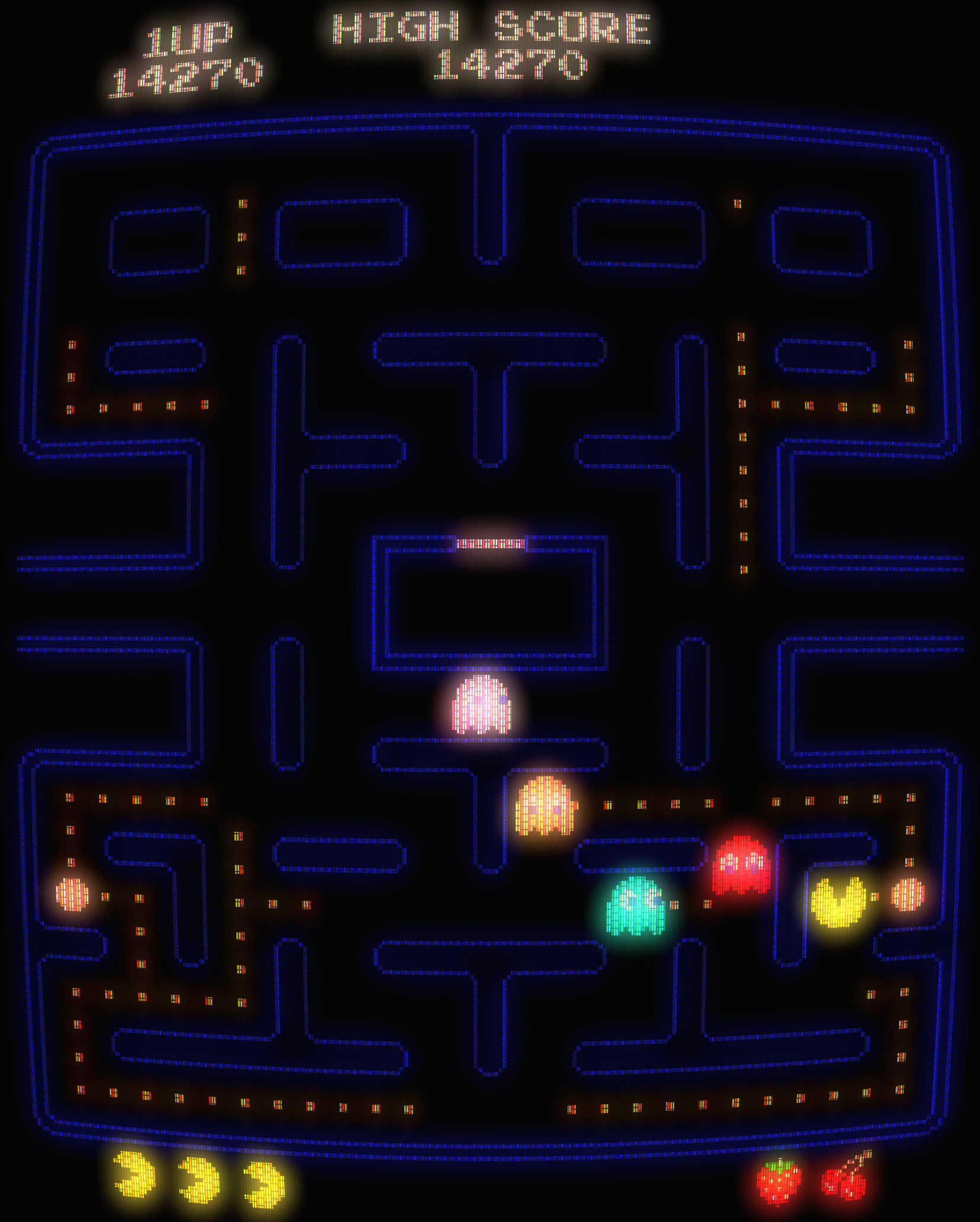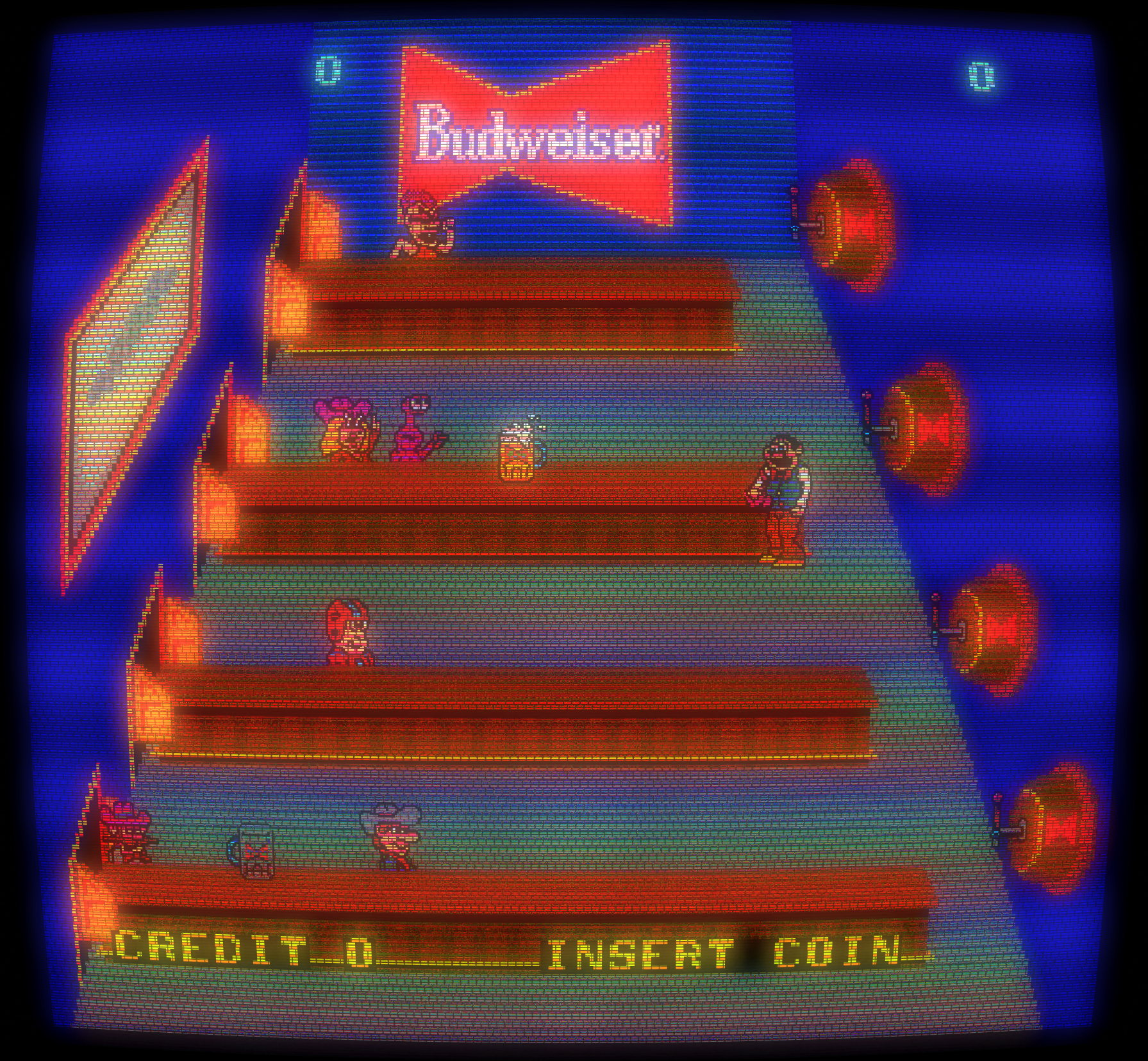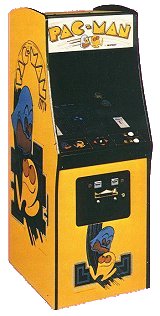
 The Game: As a round yellow creature consisting of a mouth and nothing else, you maneuver around a relatively simple maze, gobbling small dots (10 points) and evading four colorful monsters who can eat you on contact. In four corners of the screen, large flashing dots (50 points) enable you to turn the tables and eat the monsters for a brief period for an escalating score (200, 400, 800 and 1600 points). Periodically, assorted items appear near the center of the maze, and you can consume these for additional points as well. The monsters, once eaten, return to their home base in ghost form and return to chase you anew. If cleared of dots, the maze refills and the game starts again, but just a little bit faster… (Bally/Midway [under license from Namco], 1981)
The Game: As a round yellow creature consisting of a mouth and nothing else, you maneuver around a relatively simple maze, gobbling small dots (10 points) and evading four colorful monsters who can eat you on contact. In four corners of the screen, large flashing dots (50 points) enable you to turn the tables and eat the monsters for a brief period for an escalating score (200, 400, 800 and 1600 points). Periodically, assorted items appear near the center of the maze, and you can consume these for additional points as well. The monsters, once eaten, return to their home base in ghost form and return to chase you anew. If cleared of dots, the maze refills and the game starts again, but just a little bit faster… (Bally/Midway [under license from Namco], 1981)
Memories: It began in 1979 when a young Namco game designer named Toru Iwitani made his fourth video game. Fascinated with pinball, Iwitani had created a series of games combining pinball physics with Breakout-style brick-busting elements, and while Gee Bee, Bomb Bee and Cutie Q were moderate successes for Namco, enough to keep Iwitani employed and developing new titles, the designer himself was finally ready to move beyond video pinball. Cutie Q was one of the first hints as to Toru Iwitani’s next project, with its colorfully cartoony monsters. With a small team of developers at his disposal, Iwitani – supposedly inspired by the shape of a pizza with one slice removed – set about creating a new game with nearly universal appeal.
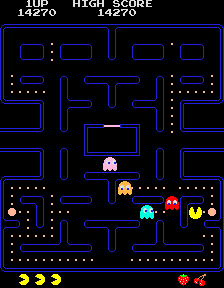 The Phenomenon: How big was Pac-Man? Simple answer: Pac-Man was huge. Sure, Space Invaders had made a big splash in 1978, as had its chief competitor at the time, Atari Football. Asteroids went over well in 1979, the same year that Namco introduced the first color-monitor video game, the Space Invaders-influenced Galaxian. But to a certain extent, those games were considered “complicated,” especially Asteroids with its five-button control cluster. Pac-Man broke through the clutter, and shattered the perception of video games as geeks-only territory, by doing two things: simplifying things down to a single-joystick control with no buttons (except for those used to select a single or dual player game), and making the game accessibly cute and nonviolent in a way that appealed to female players and kids (and their parents).
The Phenomenon: How big was Pac-Man? Simple answer: Pac-Man was huge. Sure, Space Invaders had made a big splash in 1978, as had its chief competitor at the time, Atari Football. Asteroids went over well in 1979, the same year that Namco introduced the first color-monitor video game, the Space Invaders-influenced Galaxian. But to a certain extent, those games were considered “complicated,” especially Asteroids with its five-button control cluster. Pac-Man broke through the clutter, and shattered the perception of video games as geeks-only territory, by doing two things: simplifying things down to a single-joystick control with no buttons (except for those used to select a single or dual player game), and making the game accessibly cute and nonviolent in a way that appealed to female players and kids (and their parents).
 In short, it wasn’t just the early adopters who wanted to play now – it was everyone.
In short, it wasn’t just the early adopters who wanted to play now – it was everyone.
T-shirts, bedsheets, toys, and more sprang up to meet the demand for all things Pac. Namco had granted U.S. distributor Bally/Midway a license to not only manufacture and distribute the game in North America, but to grant its own licenses for merchandise. This Midway did with great aplomb, to say the least, and without much attention to detail; the cabinet artwork of Pac-Man deviated a great deal from its Japanese Puck-Man counterpart (the original name of the game, changed in translation for fear that vandals would transform the P into an F in American arcades).
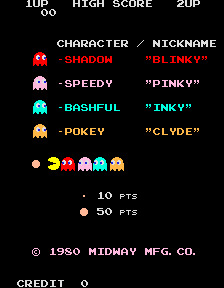 Midway’s artistic rendition of the characters, seen at left, wasn’t something it insisted on its licensees using. They were welcome to draw Pac-Man and the monsters in any way they thought would sell – indeed, some of them even wound up using something more in line with Namco’s red-booted, orange-gloved, near-Disney-esque vision of the character. Others didn’t, and soon it was nearly impossible to tell the inevitable bootleg merchandise from the real deal. But the spinoff merchandise wasn’t the only thing that wasn’t authorized.
Midway’s artistic rendition of the characters, seen at left, wasn’t something it insisted on its licensees using. They were welcome to draw Pac-Man and the monsters in any way they thought would sell – indeed, some of them even wound up using something more in line with Namco’s red-booted, orange-gloved, near-Disney-esque vision of the character. Others didn’t, and soon it was nearly impossible to tell the inevitable bootleg merchandise from the real deal. But the spinoff merchandise wasn’t the only thing that wasn’t authorized.
Spinoffs: Pac-Man inspired numerous spinoffs and many bootlegs as well. Most of the latter were very transparent attempts to grab at Midway’s share of kids’ quarters, changing nothing more than the maze and – in some more adventurous cases – the shapes of the characters.
 The existence of the bootlegs was a thorn in Midway’s side, and consequently, they offered an upgrade of their own which left the maze intact, changed a couple of colors, and replaced the assortment of fruits and objects which appeared near the center of the screen. Rumor had it, at the time, that Midway offered the Pac-Man Plus upgrade to arcade owners who would be willing to turn in their bootleg chip sets and boards (presumably so Midway could track them back to the source and prosecute). Eventually, legit spinoffs began to appear, solidifying the “eating maze” genre of game as an arcade staple.
The existence of the bootlegs was a thorn in Midway’s side, and consequently, they offered an upgrade of their own which left the maze intact, changed a couple of colors, and replaced the assortment of fruits and objects which appeared near the center of the screen. Rumor had it, at the time, that Midway offered the Pac-Man Plus upgrade to arcade owners who would be willing to turn in their bootleg chip sets and boards (presumably so Midway could track them back to the source and prosecute). Eventually, legit spinoffs began to appear, solidifying the “eating maze” genre of game as an arcade staple.
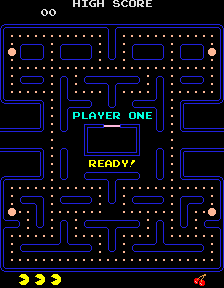 Ms. Pac-Man offered additional side tunnels, changing mazes, and foods that would try to evade you. In Super Pac-Man, game play began to change much more significantly, including “super” power pellets that would allow Pac-Man to fly over the maze, avoiding the monsters entirely while still eating objects in the maze. A pinball-video game hybrid, Baby Pac-Man, was a disaster, with a complicated structure and – since it had to fit both into one case – very substandard pinball play and a very substandard video game component. Trying to redeem that concept, Jr. Pac-Man was released, with mazes well over twice the width of the screen, introducing a scrolling element to the game. Other than the scrolling, Jr. Pac-Man was very much like Ms. Pac-Man. Pac ‘n’ Pal got very strange indeed with a helpful “Pal” character, impervious to the ever-present four monsters, who would help Pac-Man out (even though the player had no control over Pac’s Pal).
Ms. Pac-Man offered additional side tunnels, changing mazes, and foods that would try to evade you. In Super Pac-Man, game play began to change much more significantly, including “super” power pellets that would allow Pac-Man to fly over the maze, avoiding the monsters entirely while still eating objects in the maze. A pinball-video game hybrid, Baby Pac-Man, was a disaster, with a complicated structure and – since it had to fit both into one case – very substandard pinball play and a very substandard video game component. Trying to redeem that concept, Jr. Pac-Man was released, with mazes well over twice the width of the screen, introducing a scrolling element to the game. Other than the scrolling, Jr. Pac-Man was very much like Ms. Pac-Man. Pac ‘n’ Pal got very strange indeed with a helpful “Pal” character, impervious to the ever-present four monsters, who would help Pac-Man out (even though the player had no control over Pac’s Pal).
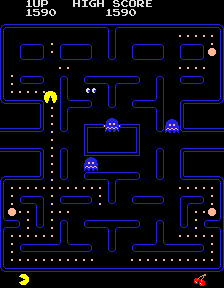 Finally, a scrolling run-and-jump game called Pac-Land, based on ABC’s short-lived Pac-Man Saturday morning cartoon broke completely with the structure of the previous Pac games, though the payoff came in the form of some stunning graphics and music which were very faithful to the cartoon’s animation. The game returned to its maze-chasing roots with Pac-Mania, which moved the series firmly into the present with a slickly-rendered isometric perspective.
Finally, a scrolling run-and-jump game called Pac-Land, based on ABC’s short-lived Pac-Man Saturday morning cartoon broke completely with the structure of the previous Pac games, though the payoff came in the form of some stunning graphics and music which were very faithful to the cartoon’s animation. The game returned to its maze-chasing roots with Pac-Mania, which moved the series firmly into the present with a slickly-rendered isometric perspective.
Surprisingly for such a simple game, licensees seemed to have a hell of a time trying to capture the essence of Pac-Man. By now, the story of the Atari 2600 version of Pac-Man has all but entered the realm of legend. It was the most eagerly-awaited home video game of 1982, and it ranks up there with Cabbage Patch Kids, Power Rangers and Tickle Me Elmo as one of those toys that just couldn’t be kept in stock to save retailers’ lives. But what emerged when people did get the coveted plastic-encased program home was not a pretty sight.
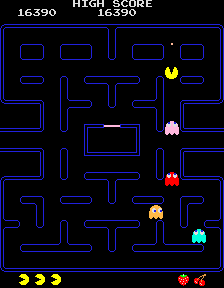 The Atari 2600 version of Pac-Man smacked even more of cheap ripoff than any of the arcade bootlegs of the game. Allowing for the machine’s admittedly limited graphics and sound ability, third-party manufacturers such as Activision had nonetheless proven that you could indeed make a good game for the 2600. Atari, with its version of Pac-Man, turned around and proved that the 2600 was also more than capable of sucking mightily as a game machine. It seemed as though every effort was spared to make the home version a faithful rendition of its progenitor. The maze bore no resemblance to the arcade game’s familiar territory, even going so far as to place the side tunnels at the top and bottom. The Atari 2600’s well-known limitation on sprites – animated characters – meant that all four ghosts were constantly flickering, making it hard to keep track of them or to determine their all-important color scheme (bright yellow for lethal, blue for their vulnerable stage, and pink standing in for the brief period before they become dangerous again. The sound effects were abysmal. Instead of the jaunty signature tune at the beginning of the game, players were treated to a series of tones not unlike a touch-tone telephone. For every dot eaten, there was an annoying, droning bleep, and the closest approximation of the arcade game could only be heard when a power pellet was eaten.
The Atari 2600 version of Pac-Man smacked even more of cheap ripoff than any of the arcade bootlegs of the game. Allowing for the machine’s admittedly limited graphics and sound ability, third-party manufacturers such as Activision had nonetheless proven that you could indeed make a good game for the 2600. Atari, with its version of Pac-Man, turned around and proved that the 2600 was also more than capable of sucking mightily as a game machine. It seemed as though every effort was spared to make the home version a faithful rendition of its progenitor. The maze bore no resemblance to the arcade game’s familiar territory, even going so far as to place the side tunnels at the top and bottom. The Atari 2600’s well-known limitation on sprites – animated characters – meant that all four ghosts were constantly flickering, making it hard to keep track of them or to determine their all-important color scheme (bright yellow for lethal, blue for their vulnerable stage, and pink standing in for the brief period before they become dangerous again. The sound effects were abysmal. Instead of the jaunty signature tune at the beginning of the game, players were treated to a series of tones not unlike a touch-tone telephone. For every dot eaten, there was an annoying, droning bleep, and the closest approximation of the arcade game could only be heard when a power pellet was eaten.
Atari’s Pac-Man, in short, blew. It was instantly bested by its contemporary competitor, Magnavox’s K.C. Munchkin for the Odyssey2, which Atari then turned around and sued successfully. (And to this day, I am convinced that this had less to do with copyright infringement than it did with the then-Warner-Bros.-owned Atari’s desire to prevent the market from perceiving it as fallible.) Though Atari later translated Ms. Pac-Man much more successfully to the “small screen,” the original 2600 version of Pac-Man is often held up, to this day, as the symbol of all the shortcomings of the sometimes undeservedly maligned Atari 2600.
 More faithful to the original game, but more obscure these days, was the Coleco toy company’s excellent table-top, battery-operated version of Pac-Man. Sporting perfect reproductions of the arcade game’s marquee and side panel artwork, the game did a much better job of approximating the arcade maze, sound effects, and pace. Admittedly, there were limitations to the L.E.D. maze, and after about thirty seconds the sounds were grating, but it was much more playable in the end than Atari’s travesty of a game.
More faithful to the original game, but more obscure these days, was the Coleco toy company’s excellent table-top, battery-operated version of Pac-Man. Sporting perfect reproductions of the arcade game’s marquee and side panel artwork, the game did a much better job of approximating the arcade maze, sound effects, and pace. Admittedly, there were limitations to the L.E.D. maze, and after about thirty seconds the sounds were grating, but it was much more playable in the end than Atari’s travesty of a game.
Coleco’s license to produce Pac-Man goodies didn’t end there, however. They produced a half-dozen bendable PVC figures of Pac-Man, Ms. Pac-Man, and other characters. Other spinoffs includes T-shirts, lunch boxes, several records (one, Pac-Man Fever by Buckner & Garcia, was reissued on CD in 1999 by popular demand; the others, including a post-Ms. Pac-Man picture disc intended for a very young audiences, have thankfully passed into aural obscurity), and a board game which involved a lot of tedious “gobbling” of white marbles from a gameboard with a difficult-to-use Pac-Man playing piece.
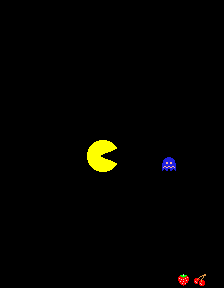 Also in the post-Ms. Pac-Man era, ABC produced a Saturday morning cartoon featuring Pac-Man, Ms. Pac-Man and Baby Pac, as well as the four “ghost monsters.” It was a kind of vastly watered-down rendition of Popeye – just substitute “power pellets” for spinach, Baby Pac for Swee’Pea…I think you can see where the analogy is going. There was some concern over how to show Pac-Man being defeated in any way, and indeed this only ever happened once on-screen in the pilot episode. After that episode, the cartoon concentrated much less on eating and being eaten than on more typical “beat the bad guys’ nasty schemes” schtick. The cartoon was later canonized in a way by the Pac-Land arcade game.
Also in the post-Ms. Pac-Man era, ABC produced a Saturday morning cartoon featuring Pac-Man, Ms. Pac-Man and Baby Pac, as well as the four “ghost monsters.” It was a kind of vastly watered-down rendition of Popeye – just substitute “power pellets” for spinach, Baby Pac for Swee’Pea…I think you can see where the analogy is going. There was some concern over how to show Pac-Man being defeated in any way, and indeed this only ever happened once on-screen in the pilot episode. After that episode, the cartoon concentrated much less on eating and being eaten than on more typical “beat the bad guys’ nasty schemes” schtick. The cartoon was later canonized in a way by the Pac-Land arcade game.
Pac-Man was ported to a variety of computer systems in many forms, both official and otherwise, and has also been featured on several “classic arcade” collections for current home video game consoles. Somehow, somewhere, every day, this game is still making money for someone.

